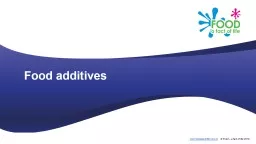

Food additives are substances added to products to perform specific technological functions These functions include preserving ie increasing shelflife or inhibiting the growth of pathogens or adding ID: 775050
Download Presentation The PPT/PDF document " Food additives What are food additives?" is the property of its rightful owner. Permission is granted to download and print the materials on this web site for personal, non-commercial use only, and to display it on your personal computer provided you do not modify the materials and that you retain all copyright notices contained in the materials. By downloading content from our website, you accept the terms of this agreement.
Slide1
Food additives
Slide2What are food additives?
Food additives are substances added to products to perform specific technological functions. These functions include preserving, i.e. increasing shelf-life or inhibiting the growth of pathogens, or adding
colour and enhancing flavour for interest and variety.There are over 300 permitted additives that can be used in the UK. Flavourings are not included in this figure, as they are classified differently. However, flavour enhancers (substances which make flavours stronger) are included.A list of approved additives can be found at the Food Standards Agency website.
Food Standards Agency, 2018European Food Safety Authority, 2014
Jams contain several kinds of additives, including emulsifiers and gelling agents.
Slide3What are E numbers?
An E number is given to an additive to show that it has been approved for use in the EU (‘E’ stands for Europe).
The European Food Safety Authority is responsible for regulating E numbers and making sure they are safe for consumption.E numbers apply to all additives, regardless of whether they come from natural sources or are man made.E numbers are individually approved for use in different foods. This means that an E number cannot be used in any food, but only in a list of foods that it is approved for, where it is deemed appropriate and safe.
Anthocyanins (E163) can be extracted from red cabbage and used as a red food colouring
Caramel (E150) is a synthetic colouring, commonly used to colour colas.
European Food Safety Authority
, 2019
Slide4Types of additives
Additives may be:
• natural – found naturally, such as extracts from beetroot juice (E162), used as a colouring agent;
•
synthetic – man-made
identical copies of substances found naturally, such as benzoic acid (E210), used as a preservative;
• artificial – produced synthetically and not found naturally, such as
nisin
(E234), used as a preservative in some dairy
products,
pasteurised
liquid eggs
and
in semolina and tapioca puddings.
Slide5Preservatives
Preservatives aim to: • prevent the growth of micro-organisms which could cause food spoilage and lead to food poisoning; • extend the shelf-life of products, so that they can be distributed and sold to the consumer with a longer shelf-life.For example, bacon, ham, corned beef and other ‘cured’ meats are often treated with nitrite and nitrate (E249 - E252) during the curing process.
Slide6Antioxidants
Antioxidants aim to: • prevent food containing fat or oil from going rancid due to oxidation (i.e. developing an unpleasant odour or flavour); • prevent the browning of cut fruit, vegetables and fruit juices (and so increase shelf life and appearance). Vitamin C, also known as ascorbic acid, or E300, is one of the most widely used antioxidants.
Slide7Colours
Colours aim to: • restore colour lost during processing or storage, e.g. marrowfat peas;• ensure that each batch produced is identical in appearance or does not appear ‘off’;• reinforce colour already in foods, e.g. enhance the yellowness of a custard;• give colour to foods which otherwise would be colourless (e.g. soft drinks) and so make them more attractive.
Slide8Colours and hyperactivity
Certain combinations of artificial food colours have been linked to a negative effect on children’s behaviour : sunset yellow (E110)quinoline yellow (E104)carmoisine (E122)These colours are used in soft drinks, sweets and ice cream. Food and drink containing any of these six colours must carry a warning on the packaging, which reads: ‘May have an adverse effect on activity and attention in children’.
allura
red (E129)tartrazine (E102)ponceau 4R (E124)
Food Standards Agency
, 2018
Slide9Flavour enhancers
Flavour enhancers bring out the flavour in foods without imparting a flavour of their own, e.g. monosodium glutamate (E621) enhances umami flavours.Flavourings, on the other hand, are added to a wide range of foods, usually in small amounts to give a particular taste. These do not have E numbers because they are controlled by different food laws. Ingredients lists will say if flavourings have been used, but individual flavourings might not be named.
Slide10Sweeteners
Sweeteners include: • intense sweeteners (e.g. acesulfame K, aspartame and stevia) have a sweetness many times that of sugar and therefore are used in small amounts, e.g. in soft drinks and sweetening tablets;• bulk sweeteners, e.g. sorbitol, have a similar sweetness to sugar and are used at similar levels. Sorbitol is often used in sugar-free chewing gum and sweets.
Glucose (top) and aspartame (bottom). Both are sweet but are structurally very different.
Slide11Acids, bases and buffers
Acids, bases and buffers control the acidity or alkalinity of food, for safety and stability of flavour.
Slide12Anti-caking agents
Anti-caking
agents ensure free movement or flow of particles (e.g. in dried milk or table salt).Anti-foaming agentsAnti-foaming agents prevent or disperse frothing (e.g. in the production of fruit juices).
Slide13Glazing agents
Glazing agents provide a protective coating or sheen on the surface of foods, e.g. confectionery (for appearance and shelf-life).
Slide14Emulsifiers, stabilisers, gelling agentsand thickeners
Emulsifiers help mix ingredients together that would normally separate (e.g. lecithins (E322)).Stabilisers prevent ingredients from separating again, e.g. locust bean gum (E410).Emulsifers and stabilisers give food a consistent texture. They can be found in low-fat spreads.Gelling agents are used to change the consistency of a food (e.g. pectin (E440)), which is used to make jam.Thickeners help give food body and can be found in most sauces.
Lecithins can be found in egg yolks and soya beans
Slide15Food additives
For further information, go to:
www.foodafactoflife.org.uk